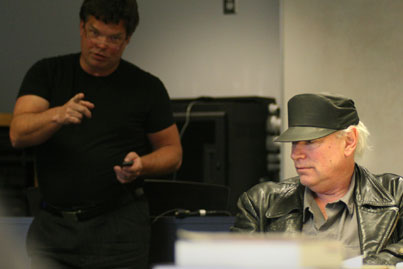From Liszt to Led: New music course plugs in
From Liszt to Led: New music course plugs in McGill University
User Tools (skip):
Bourguignon Beat
From Liszt to Led: New music course plugs in

Cool enough for school: Dean Don McLean and legendary rock producer Sandy Pearlman explain the link between Bruckner and "War Pigs."
Owen Egan
It's not every day you hear an academic begin a sentence with the words "Ozzy posits..." but this is no ordinary class. It's the Schulich School of Music's new seminar series, Bruckner and Heavy Metal: From Chord Power to Power Chord. And the academic in question is Distinguished Visiting Scholar Sandy Pearlman or, as he introduces himself to the inaugural class, "I'm Christopher Walken, or rather, Christopher Walken is me."
A few blank stares greet the reference to the classic Saturday Night Live skit in which Walken spoofs Pearlman as producer of the Blue Öyster Cult, but no matter. After a rocky start as Don McLean, Dean of the Schulich School of Music and the course's co-teacher, fiddles with the audio system in the classroom equivalent of the last-minute sound check, class is in session and it's time to rock and, uh... orchestrate.
First off, McLean hands out surveys, asking if the students are — like himself — a little more Bruckner or — like Pearlman — a little more heavy metal, or perhaps even "that rare bird who likes both."
As it turns out, at least one of the students is that rare bird.
Eric Smialek, a 24-year-old musicology student told the Reporter, "Whether I'm at home listening to a Mahler symphony or to Cannibal Corpse, I get the same kind of bodily reaction, walking around the house with my arms in the air." Smialek's master's thesis is on heavy metal but he has performed both in death metal bands and in choirs.
"I've always made parallels (between the two forms of music)," he said. "I'm more comfortable on the metal side, but I also have a huge interest in 19th-century orchestral music, so this is pretty ideal for me." His advisor, Professor David Brackett, chair of the Department of Music Theory, suggested he sign up for McLean and Pearlman's new class. With references to Bruckner, Liszt and Bach interspersed with the renderings of Jimi Hendrix, Led Zeppelin and AC/DC, the class bears witness to the growing open-mindedness of scholars, said Smialek.
Some of the students also seem determined to keep an open mind. Andie Sigler, who is pursuing a master's in music theory, admits she knows nothing about heavy metal. "I've never listened to it," said the 23-year-old, "but I took this class because I want to understand how music works. I'm not here to listen to music for enjoyment; I'm here to learn."
And learn she shall.
"Anton Bruckner is the single most radical composer in the European orchestral tradition," explains Pearlman, noting the classical portion of the course's play list "embodies the sonorific, ecstasy-building, complex form and structure that are uniquely Brucknerian."
"Heavy metal is its evil twin," he adds.
To illustrate, McLean cues up an anthemic, brass-powered Bruckner symphony, pointing out unexpected chord progressions and unusual rhythmic patterns, followed by a track from the Pearlman-produced Blue Öyster Cult that features similarly complex tricks of the musical trade.
Pearlman looks down nostalgically as the track plays. "There's the brass," he says by way of comparison, looking up with a smile, "though it's actually something like 18 guitars."
An in-depth discussion of the meaning of it all eventually leads to the topic of lyrics as a form of musical expression. In the case of heavy metal, McLean points out, lyrics can either be like medieval poetry (think Iron Maiden's Coleridge-inspired "Rime of the Ancient Mariner," suggests Pearlman) or, in a word, drivel.
"'War Pigs'!" McLean suddenly exclaims, his arms outstretched.
"Black Sabbath," a nodding Pearlman explains to the uninitiated. 'War Pigs' is a very profound meta-criticism of the modern military industrial complex. Ozzy posits that this is the fount of all evil. This is a very interesting text."
Ozzy Osbourne, the iconic former Black Sabbath singer and walking — well, shuffling — warning on the dangers of recreational pharmaceuticals, would probably never claim any direct lineage to Bruckner, even in his least lucid moments; however, Pearlman argues, "heavy metal had a large series of prerequisites before it could appear and bless us with its presence."
After McLean has pointed out that one of Bruckner's biggest fans was fellow Austrian Adolf Hitler, Pearlman elaborates. "We owe the creation of heavy metal to the Third Reich," he says, "because a lot of the Jewish composers who left Europe went on to compose for Hollywood horror films. They exposed kids to a Brucknerian vocabulary and it subsequently morphed into heavy metal."
Despite such fascinating twists and turns, McLean stresses, the point of this class is not to present a history of heavy metal or the life and musical times of Anton Bruckner. The point is to analyze and understand how music is made — and whether it's by Bruckner or Blue Öyster Cult, it seems music is still a universal language.

